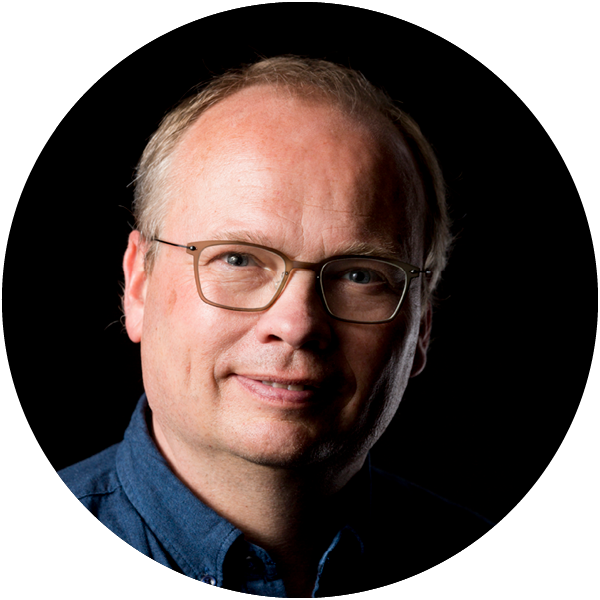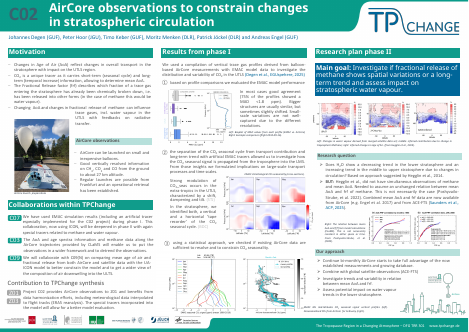
Project C02:
AirCore observations to constrain changes in
stratospheric circulation
Brief Summary
In project C02 we perform regular AirCore observations using small balloons launched from Frankfurt. These measurements have been started during phase I of our CRC and allow for the measurements of vertical profiles of CO, CH4 and CO2 on a bimonthly basis. This is a very cost-effective method of getting information on trace gas distribution up to altitudes of about 27 km. These data will be combined with similar observations from Boulder/Colorado and other locations in Europe, and with satellite data from the ACE-FTS instrument. This allows us to build a data base of trace gas distributions in the lower stratosphere. From the CO2 measurements we can derive mean age, which is a measure of the transport time needed to exchange airmasses between the troposphere and the stratosphere and thus also a measure of the strength of the stratospheric circulation. A changing stratospheric circulation should influence both mean age and also the chemical breakdown of CH4, methane. Therefore, we will complete the analysis by also looking at the ratio of methane at a given location relative to its tropospheric abundance. The more photochemistry an air parcel has experienced since its last contact with the troposphere, the less methane there should be. Therefore, this can give us something like a photochemical age. Comparing this to the observed mean age at the same location can give insight into changing transport pathways. The photochemical breakdown of methane will produce water vapour, so these processes also influence the water vapour distribution in the lower stratosphere. Therefore, we will investigate the change in mean age and methane and in the correlation between them and compare the observed changes to model results.
Project Poster
Members

Prof. Dr. Andreas Engel
Principal Investigator
Goethe-Universität Frankfurt, Institut für Atmosphäre und Umwelt
an.engel[at]iau.uni-frankfurt.de

Former Member Phase I:
Timo Keber
Technician
Goethe-Universität Frankfurt, Institut für Atmosphäre und Umwelt

Former Member Phase I:
Johannes Degen
Associated Doctoral Candidate
Goethe-Universität Frankfurt, Institut für Atmosphäre und Umwelt
Publications
Degen, J., B. C. Baier, P. Jöckel, J. M. Menken, T. J. Schuck, C. Sweeney, and A. Engel (2025): CO2 variability and seasonal cycle in the UTLS: insights from EMAC model and AirCore observational data. Atmospheric Chemistry and Physics 25 (22), 15741–15763. doi: 10.5194/acp-25-15741-2025
Jesswein, M., V. Lauther, N. Emig, P. Hoor, T. Keber, H.-C. Lachnitt, L. Ort, T. Schuck, J. Strobel, R. Van Luijt, C. M. Volk, F. Weyland, and A. Engel (2025): Tracing elevated abundance of CH2Cl2 in the subarctic upper troposphere to the Asian Summer Monsoon. Atmospheric Chemistry and Physics 25 (14), 8107–8126. doi: 10.5194/acp-25-8107-2025
Saunders, L. N., K. A. Walker, G. P. Stiller, T. von Clarmann, F. Haenel, H. Garny, H. Bönisch, C. D. Boone, A. E. Castillo, A. Engel, J. C. Laube, M. Linz, F. Ploeger, D. A. Plummer, E. A. Ray, and P. E. Sheese (2025): Age of air from ACE-FTS measurements of sulfur hexafluoride. Atmospheric Chemistry and Physics 25 (7), 4185–4209. doi: 10.5194/acp-25-4185-2025.
Schuck, T. J., J. Degen, T. Keber, K. Meixner, T. Wagenhäuser, M. Ghysels, G. Durry, N. Amarouche, A. Zanchetta, S. van Heuven, H. Chen, J. C. Laube, S. L. Baartman, C. van der Veen, M. E. Popa, and A. Engel (2025): Measurement report: Greenhouse gas profiles and age of air from the 2021 HEMERA-TWIN balloon launch. Atmospheric Chemistry and Physics 25 (7), 4333–4348. doi: 10.5194/acp-25-4333-2025
Schuck, T. J., J. Degen, E. Hintsa, P. Hoor, M. Jesswein, T. Keber, D. Kunkel, F. Moore, F. Obersteiner, M. Rigby, T. Wagenhäuser, L. M. Western, A. Zahn, and A. Engel (2024): The interhemispheric gradient of SF6 in the upper troposphere. Atmospheric Chemistry and Physics 24 (1), 689–705. doi: 10.5194/acp-24-689-2024.
Wagenhäuser, T., M. Jesswein, T. Keber, T. Schuck, and A. Engel (2023): Mean age from observations in the lowermost stratosphere: an improved method and interhemispheric differences. Atmospheric Chemistry and Physics 23 (7), 3887–3903. doi: https://doi.org/10.5194/acp-23-3887-2023.
Jesswein, M., R. P. Fernandez, L. Berná, A. Saiz-Lopez, J.-U. Grooß, R. Hossaini, E. C. Apel, R. S. Hornbrook, E. L. Atlas, D. R. Blake, S. Montzka, T. Keber, T. Schuck, T. Wagenhäuser, and A. Engel (2022): Global seasonal distribution of CH 2 Br 2 and CHBr 3 in the upper troposphere and lower stratosphere. Atmospheric Chemistry and Physics 22 (22), 15049–15070. doi: https://doi.org/10.5194/acp-22-15049-2022.


